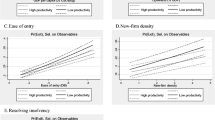Abstract
The purpose of this paper is to explicitly examine the impact that two distinct methods used to measure entry have on identifying the determinants of entry. The two approaches can be termed as the ecological approach and the labor market approach. Based on new business startups in 75 regional markets in West Germany, we find that the two different methods for measuring entry yield disparate results. Most strikingly, we find that the ecological approach yields a positive relationship between unemployment and startup activity, while the labor market approach points to a negative impact of unemployment on the startup of new firms. By decomposing these two measures we offer a reconciliation of what appears to be a measurement contradiction.
Similar content being viewed by others
References
Acs, Zoltan J., and David B. Audretsch (1990)Innovation and Small Firms. Cambridge, MA: MIT Press.
Acs, Zoltan J., and David B. Audretsch (1989) ‘Small-Firm Entry in U.S. Manufacturing’,Economica,56, 255–265.
Audretsch, David B. (1993) ‘New-Firm Formation in U.S. Manufacturing’, in Bengt Johannisson, Charlie Karlsson, and David Storey, eds,Small Firm Dynamics: International, National, and Regional Perspectives. London: Routledge.
Audretsch, David B., and Michael Fritsch (1992) ‘Market Dynamics and Regional Development in the Federal Republic of Germany’,Discussion Paper FS IV 92-6, Wissenschaftszentrum Berlin für Sozialforschung, March 1992.
Audretsch, David B. and Michael Fritsch (1994) ‘The Geography of Firm Births in Germany’Regional Studies,28, 355–361.
Audretsch, David B. and Marco Vivarelli (1995) ‘New Firm Startups’,Economic Policy,19.
Dahrenmöller, Alex (1987)Existenzgründungsstatistik: Nutzung amtlicher Datenquellen zur Erfassung des Gründungsgeschehens. Stuttgart: C.C. Poeschel.
Evans, David, and Byron Jovanovic (1989) ‘Estimaties of a Model of Entrepreneurial Choice under Liquidity Constraints’,Journal of Political Economy,95, 657–679.
Evans, David S., and Linda Leighton (1990) ‘Small Business Formation by Unemployed and Employed Workers’,Small Business Economics,2, 319–330.
Evans, David S., and Linda Leighton (1989) ‘The Determinants of Changes in U.S. Self-Employment, 1968–1987’,Small Business Economics,1, 111–120.
Fritsch, Michael (1992) ‘Regional Differences in New Firm Foundation: Evidence from West Germany’,Regional Studies,25, 233–241.
Geroski, Paul, and Joachim Schwalbach, eds (1991)Entry and Market Contestability: An International Comparison. Oxford: Basil Blackwell.
Highfield, Richard, and Robert Smiley (1987) ‘New Business Starts and Economic Activity: An Empirical Investigation’,International Journal of Industrial Organization,5, 51–66.
Krugman, Paul (1991a) ‘Increasing Returns and Economic Geography’,Journal of Political Economy, 99, 483–499.
Krugman, Paul (1991b)Geography and Trade. Cambridge, MA: MIT Press.
Reynolds, Paul D. (1993) ‘Regional Characteristics Affecting Autonomous Branch Establishment Foundings in the U.S., 1976–1986’, in Bengt Johannisson, Charlie Karlsson and David Storey, eds,Small Firm Dynamics: International, National, and Regional Perspectives. London: Routledge.
Reynolds, Paul D. (1992) ‘Predicting New-Firm Births: Interactions of Organizational and Human Populations’, in Donald L. Sexton, and John D. Kasarda, eds,The State of the Art of Entrepreneurship. Boston: PWS Kent Publishing.
Reynolds, Paul D. (1991) ‘Strategies for Cross-National Comparisons: Matching Research Issues and Analysis Objectives’,Small Business Economics,3, 245–260.
Storey, David J. (1991) ‘The Birth of New Firms-Does Unemployment Matter? A Review of the Evidence’,Small Business Economics,3, 167–178.
Storey, David J. and Steven Johnson (1987)Job Generation and Labour Market Changes. London: Macmillan.
Yamawaki, Hideki (1991) ‘The Effects of Business Conditions on Net Entry: Evidence from Japan’, in Paul Geroski, and Joachim Schwalbach, eds,Entry and Market Contestability: An International Comparison, Oxford: Basil Blackwell.




